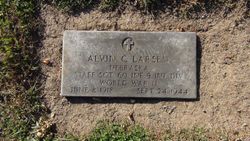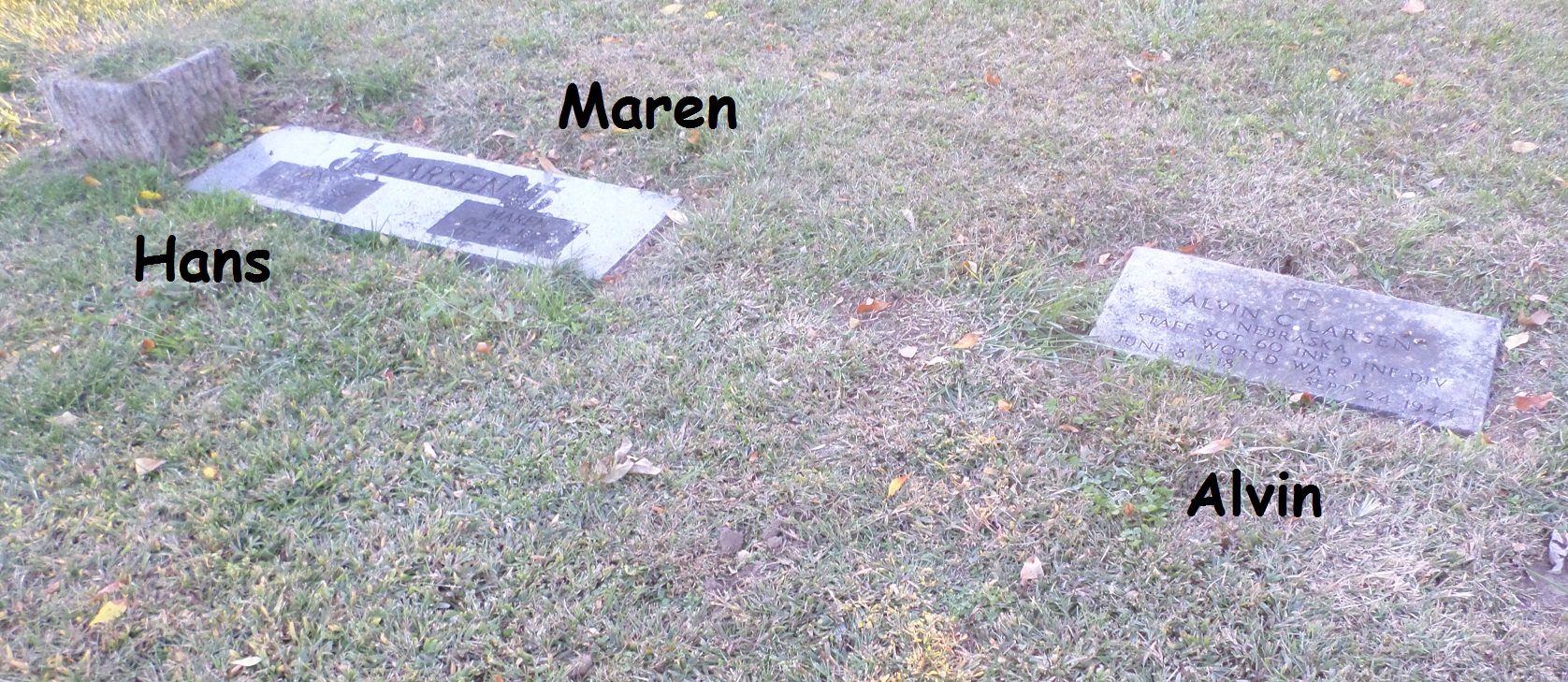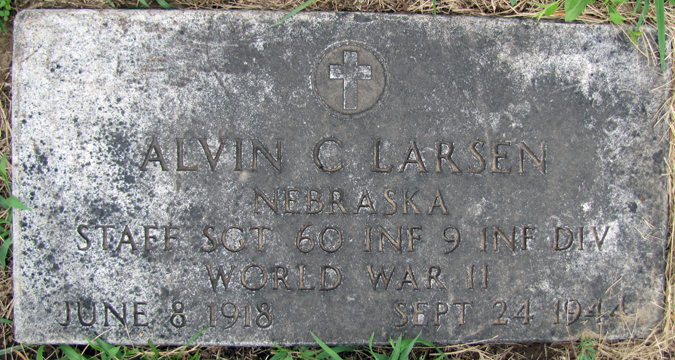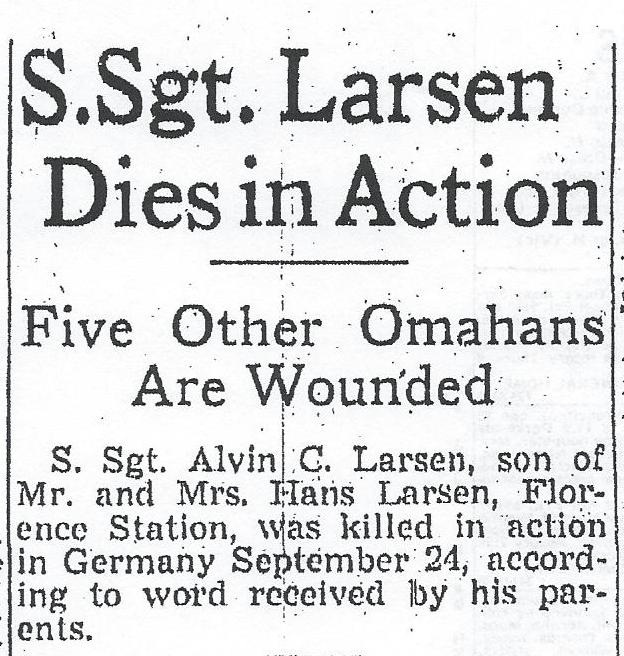Online Cemetery Record
Death year incorrectly entered into cemetery records as 1818
Death year incorrectly entered into cemetery records as 1947
World War II Casualty Designated as DOW (Died of Wounds)
Combat Activities of the 60th Infantry Regiment, 9th Infantry Division at the time of SSG Larsen's Death
France or Germany?
During the next three months, the Allied pincers began closing on the German Fatherland, but two major obstacles stood in the way – The Meuse River and the Siegfried Line. After a lapse of 26 years, on September 4th, 1944, the 60th again found itself on the west bank of the Meuse River. By September 17th, the Hofen position of the Siegfried Line was being patrolled by elements of the 60th Regiment. After the Siegfried Line was breached the Allied drive continued toward the Roer River. In a quick change of direction, the 1st Battalion of the 60th Regiment diverted to capture the vital Germeter-Hurtgen road junction. Some of the most brutal warfare took place in this area and losses were high. After capturing the road junction they captured more prisoners than they had men present for duty in the Battalion. Even though the result of this battle was successful, many lives were lost during the weeks of the heavy and fierce fighting in the darkness of the Hurtgen Forest.
*
MINE
The 9th Infantry Division began a series of attacks within the Hurtgen Forest in mid-September. The Hurtgen Forest is a deeply wooded area a rough, irregular terrain which is situated between Duren, to the north, Monschau to the south, and the town of Aachen to the west. This time of year the forest was especially gloomy with limited sunlight, mud and snow in the ground, and cold and damp.
*
What was gained in this battle? The Americans conquered 50 square miles of real estate of no real tactical value to future operations, and they had destroyed enemy troops and reserves, which the other side could ill afford to lose. The Germans, on the other hand, with meager resources, had slowed down a major Allied advance for 3 months. At the end of November, vital targets, dams along the Roer River, the importance of which were not realized until late in the fighting in the the Battle of Hürtgen Forest, were still in German hands.
*
(The Battle of Hürtgen Forest was fought in an area of heavy forestation, of some 50 square miles in an area that begins about 5 miles south and east of Aachen, Germany and falls into a triangle outlined by Aachen, Düren and Monschau.
*
MINE
The Battle of Hürtgen Forest did not officially end until February of 1945, but the heaviest loeese were by far sustained during the period from mid-September through mid-December 1944. The 9th Infantry Division's 39th and 60th Regiments were involved in two major actions; the first taking place on September 13 - 26, 1944, and the second taking place on October 6 - 26, 1944.
*
of The battle claimed 24,000 Americans; killed, missing, captured and wounded, plus another 9,000 who succumbed to trench foot, respiratory diseases and combat fatigue.)
*
9th Infantry Division
("Old Reliable Division"
Major General Louis A. Craig
39th Infantry Regiment, 47th Infantry Regiment,
60th Infantry Regiment and supporting units.
Approximate Dates Involved:
September 13 - 26, 1944 &
October 6 - 26, 1944 The 47th Infantry Regiment saw action again in November 1944.
Noted areas of action:
Zweifall, Vicht, Schevenhütte, Lammersdorf,
Rollesbroich, Todtenbruch, Richelskaul,
Raffelsbrand, Germeter, Merode, Langerwehe,
Roetgen and Paustenbach.
Losses
3836 during first attack and 4500 during second
attack.
*
Objectives were the village of Germeter and Vossenack, the main road between Monschau in the south and Duren in the north, and several road junctions in that area. Men of the 39th and 60th Infantry Regiment fought through the forest to seize the ridge behind Vossenack, overlooking the dammed up Ruhr River. The mission of VII Corps was to gain control of the Ruhr River dams, although this objective was not primary during the first few weeks of battle. The dams had to be taken after Allied commanders feared that the Germans might blow the dams and flood the grounds east of the city of Aachen. The battles for the men of the 9th Division were brutal. Last ditch German defenders were holed up in massive fortifications within the fog-ridden woods. Trees were everywhere; on high ridges, steep slopes or muddy lowlands. Artillery and mortar observers found it almost impossible to adjust their fire. Fields of fire for machine gunners were non-existent for the most part. The Ninth's drive became a slow, cold, wet and bloody struggle with ever-mounting casualties. Aachen fell to VII Corps on October 21st, 1944. When the men of 39th and 60th Infantry Regiments were pulled off the lines for some well-deserved rest at Camp Elsenborn, men of the 47th Infantry Regiment were involved in battles in the northern shoulder of the Hurtgen Forest. Objectives such as the Frenzenburg Castle, Eschweiller and Hamich were taken late November. No rest for the 9th Infantry Division!
*****
60th Infantry Regiment's actions near Monschau:
On the right flank of the 9th Infantry Division the 60th Infantry Regiment moved southeast out of Eupen to Monschau on September 14th, 1944. Task Force Buchanan, with the 1st Battalion of the 60th Regiment as a nucleus, moved south out of Eupen, turned right through Sourbrodt and Camp Elsenborn, and then proceeded north to Monschau. The two forces tied in on September 17th and then attempted to cleanup the high ground to the southeast, including Hofen and Alzen. They continued on this mission until relieved by troops of the 4th Cavalry Group, after which they moved north for the attack on Germeter.*1
*Germeter did not begin until October, so it seems likely that Alvin died after the 60th tied up with the 4th cav and they moved to clear the high ground to the SE (hofen and Alzen)
Online Cemetery Record
Death year incorrectly entered into cemetery records as 1818
Death year incorrectly entered into cemetery records as 1947
World War II Casualty Designated as DOW (Died of Wounds)
Combat Activities of the 60th Infantry Regiment, 9th Infantry Division at the time of SSG Larsen's Death
France or Germany?
During the next three months, the Allied pincers began closing on the German Fatherland, but two major obstacles stood in the way – The Meuse River and the Siegfried Line. After a lapse of 26 years, on September 4th, 1944, the 60th again found itself on the west bank of the Meuse River. By September 17th, the Hofen position of the Siegfried Line was being patrolled by elements of the 60th Regiment. After the Siegfried Line was breached the Allied drive continued toward the Roer River. In a quick change of direction, the 1st Battalion of the 60th Regiment diverted to capture the vital Germeter-Hurtgen road junction. Some of the most brutal warfare took place in this area and losses were high. After capturing the road junction they captured more prisoners than they had men present for duty in the Battalion. Even though the result of this battle was successful, many lives were lost during the weeks of the heavy and fierce fighting in the darkness of the Hurtgen Forest.
*
MINE
The 9th Infantry Division began a series of attacks within the Hurtgen Forest in mid-September. The Hurtgen Forest is a deeply wooded area a rough, irregular terrain which is situated between Duren, to the north, Monschau to the south, and the town of Aachen to the west. This time of year the forest was especially gloomy with limited sunlight, mud and snow in the ground, and cold and damp.
*
What was gained in this battle? The Americans conquered 50 square miles of real estate of no real tactical value to future operations, and they had destroyed enemy troops and reserves, which the other side could ill afford to lose. The Germans, on the other hand, with meager resources, had slowed down a major Allied advance for 3 months. At the end of November, vital targets, dams along the Roer River, the importance of which were not realized until late in the fighting in the the Battle of Hürtgen Forest, were still in German hands.
*
(The Battle of Hürtgen Forest was fought in an area of heavy forestation, of some 50 square miles in an area that begins about 5 miles south and east of Aachen, Germany and falls into a triangle outlined by Aachen, Düren and Monschau.
*
MINE
The Battle of Hürtgen Forest did not officially end until February of 1945, but the heaviest loeese were by far sustained during the period from mid-September through mid-December 1944. The 9th Infantry Division's 39th and 60th Regiments were involved in two major actions; the first taking place on September 13 - 26, 1944, and the second taking place on October 6 - 26, 1944.
*
of The battle claimed 24,000 Americans; killed, missing, captured and wounded, plus another 9,000 who succumbed to trench foot, respiratory diseases and combat fatigue.)
*
9th Infantry Division
("Old Reliable Division"
Major General Louis A. Craig
39th Infantry Regiment, 47th Infantry Regiment,
60th Infantry Regiment and supporting units.
Approximate Dates Involved:
September 13 - 26, 1944 &
October 6 - 26, 1944 The 47th Infantry Regiment saw action again in November 1944.
Noted areas of action:
Zweifall, Vicht, Schevenhütte, Lammersdorf,
Rollesbroich, Todtenbruch, Richelskaul,
Raffelsbrand, Germeter, Merode, Langerwehe,
Roetgen and Paustenbach.
Losses
3836 during first attack and 4500 during second
attack.
*
Objectives were the village of Germeter and Vossenack, the main road between Monschau in the south and Duren in the north, and several road junctions in that area. Men of the 39th and 60th Infantry Regiment fought through the forest to seize the ridge behind Vossenack, overlooking the dammed up Ruhr River. The mission of VII Corps was to gain control of the Ruhr River dams, although this objective was not primary during the first few weeks of battle. The dams had to be taken after Allied commanders feared that the Germans might blow the dams and flood the grounds east of the city of Aachen. The battles for the men of the 9th Division were brutal. Last ditch German defenders were holed up in massive fortifications within the fog-ridden woods. Trees were everywhere; on high ridges, steep slopes or muddy lowlands. Artillery and mortar observers found it almost impossible to adjust their fire. Fields of fire for machine gunners were non-existent for the most part. The Ninth's drive became a slow, cold, wet and bloody struggle with ever-mounting casualties. Aachen fell to VII Corps on October 21st, 1944. When the men of 39th and 60th Infantry Regiments were pulled off the lines for some well-deserved rest at Camp Elsenborn, men of the 47th Infantry Regiment were involved in battles in the northern shoulder of the Hurtgen Forest. Objectives such as the Frenzenburg Castle, Eschweiller and Hamich were taken late November. No rest for the 9th Infantry Division!
*****
60th Infantry Regiment's actions near Monschau:
On the right flank of the 9th Infantry Division the 60th Infantry Regiment moved southeast out of Eupen to Monschau on September 14th, 1944. Task Force Buchanan, with the 1st Battalion of the 60th Regiment as a nucleus, moved south out of Eupen, turned right through Sourbrodt and Camp Elsenborn, and then proceeded north to Monschau. The two forces tied in on September 17th and then attempted to cleanup the high ground to the southeast, including Hofen and Alzen. They continued on this mission until relieved by troops of the 4th Cavalry Group, after which they moved north for the attack on Germeter.*1
*Germeter did not begin until October, so it seems likely that Alvin died after the 60th tied up with the 4th cav and they moved to clear the high ground to the SE (hofen and Alzen)
Bio by: Sheila
Family Members
Sponsored by Ancestry
Advertisement
Records on Ancestry
Sponsored by Ancestry
Advertisement










